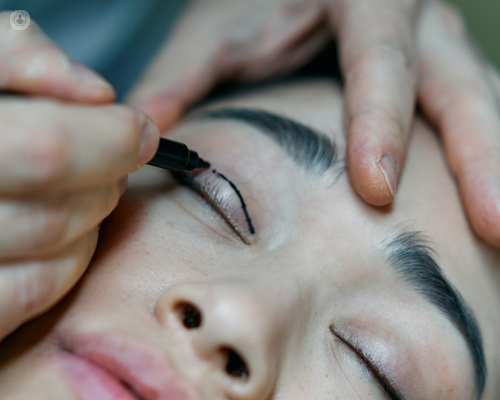Eyelid surgery: An in-depth guide
Written by:There are many functional as well as cosmetic reasons that someone may consider undergoing eyelid surgery (blepharoplasty).
In this interview, esteemed consultant eye surgeon Mr Andrew Coombes gives expert insight into what patients can expect during and after this type of procedure, as well as outlining the benefits and risks involved.

Are there different types of eyelid surgery?
There are certainly different types of eyelid surgery that I perform and generally recognise.
The broad division is functional and cosmetic. Cosmetic being designed to reverse periocular ageing, while functional would be to do with, for example, reconstruction after skin tumour. It's surprisingly common to have skin tumours and skin tumours around the eyes, affecting the eyelid, and reconstructing those would be relevant.
Also, particularly relevant to my work and the work I do in the NHS, is a lot of trauma reconstructive work so post trauma, trying to re-establish function and secondarily cosmesis of the eyelids is an important part of my work. There's a wide range. There's an overlap between cosmetic and functional surgery, for example involutional or age-related droopy eyelids, or eyelids that are turning in or out; they have a functional and cosmetic element to them. They require surgery and can be quite a big part of the work that oculoplastic surgeons like myself do.
Can there be functional as well as cosmetic reasons for eyelid surgery?
There certainly is, and there's certainly an overlap. An example in a cosmetic sense would be upper eyelid blepharoplasty where dermatochalasis, or excess skin - what appears to be excess skin - and often increased by brow descent; that skin falls down over the eyelashes and actually begins to effectively close the eye, and reduce the field of vision.
A significant proportion of upper eye lid blepharoplasty patients are suffering from a field [of vision] defect and therefore that would be deemed a functional problem. Also, the fact that the brows descend so you compensate by raising your eyebrows. This can cause headache and periocular aching sensations; it can even precipitate migraines. That's all because of this need to lift the skin out of the way, and improve the field of vision, and the vision per se. So, an upper eyelid blepharoplasty or brow surgery can actually resolve those migraines and that periocular headache, and aching sensations. There's a couple of examples where there's a significant functional component to what would be considered a cosmetic procedure.
What are the benefits and risks of having eyelid surgery?
All surgery, practically in the body, there would be discussions about infection, bleeding and scarring. We're very lucky in the eyelids in that we can make incisions where minimal or no scarring occurs. It's virtually invisible to see where we've been.
Infection is also extremely rare with eyelid surgery, possibly because - we give antibiotics - but also because it's a very vascular area; there's lots of blood vessels. That probably explains why bleeding can occur. Catastrophic or serious bleeding is almost unheard of, but bruising around the eyelids in the post op phase is very common and patients need to be aware of that.
Otherwise, in terms of eyelid surgery, if we're operating on both sides - and even if we're not - we do symmetry, under and over correction of things that we would talk about and think about in terms of the risks and benefits of eyelid surgery. Obviously, we want to leave people looking as symmetrical as possible. Cosmetically that's an important aim, so in that context we have to warn people that residual symmetry under/over correction can occur. Usually that means that we may be considering a reoperation, so we tell everyone that reoperation is a possibility after surgery. Thankfully that's pretty unusual and often it's very minor if it's needed at all. One functional issue that we'd emphasise for many eyelid surgeries is the possibility of having some dry eye in the post-operative phase. It's usually temporary but some people do have a slight tendency towards dry eye that they might not be aware of, and eyelid surgery can be the moment or the tipping point where they become more aware of a background issue with dry eyes. We would be mentioning dry eyes to people as a possibility.
I think that covers the main risks and benefits of eyelid surgery, and the main concerns. Obviously different specific procedures have a particular different risk, for example fat removal in blepharoplasty would have additional risks that we'd want to talk about.
What's involved in eyelid surgery procedures? Is it painful?
I think the short answer to that is that's it isn't painful. Most eyelid surgery is done as day-case surgery under local anaesthesia with sedation. Sedation really means that you're not aware of any unpleasant sensations; you're not going to see anything unpleasant during the surgery.
Very often you have your eyes shut so you're not going to see anything, and you're not going to feel anything. Local anaesthetic injections are stinging but sedation is very effective at minimising that and keeping people comfortable during surgery.
In outpatient surgery, where sedation is less widely used, the injection does sting a little - it's a little bit like a dental injection and it works very quickly.
For the majority of significant eyelid surgery, that's all done in the main operating theatre with local sedation. In the post-operation phase, it's surprisingly comfortable so we only really recommend paracetamol. We ask patients to avoid aspirin and ibuprofen because it can tend to make bruising worse. We tend to ask patients to avoid those types of analgesics in the immediate post-op phase. For most people they can just get on with their normal day-to-day activities unimpeded by discomfort.
Immediately after surgery we do put pads and dressings on the eye, but if we're doing both eyes then we would only put those on for 30 minutes under normal circumstances. If we're putting them on one eye, often we recommend overnight or six to eight hours. That's something to consider in the post-op phase.
It's certainly not a painful procedure in general.
How long does it take to recover from eyelid surgery?
In general, because of the bruising and swelling, we do advise there's going to be some visible evidence of surgery that isn't insignificant for seven to 10 days. Most stitches are removed at around seven days even if they're dissolving because it aids healing. I normally say that it's really just immediately after the stiches are removed that you really begin to turn the corner. I warn most people that in fact bruising and swelling tends to be more visible two to three days post-op. In the immediate post-op for a day or two it can be relatively minimal, and then the swelling could increase. Although it's worth making the point that everybody is a little bit different. Some people recover very quickly and bruise very little; others are slightly different.
Bruising does recover and go away, and most people can be fully back to normal activities within a week, although if you're very much in the public eye where you're concerned about some of the post-operative being a little bit noticeable, I say 10 days. Although in that context, make up can be worn quite soon after eyelid surgery and particularly after suture removal. That can deal with that potential concern but seven to 10 days I'd normally recommend people take down time after eyelid surgery.
What should people do, or avoid doing, after surgery?
After surgery I do, just empirically ask people to be gentle with themselves; take it easy for the seven-to-10-day period that swelling and bruising and recovery is taking place. I ask them not to take ibuprofen and aspirin because that can cause bruising, and on that note, I normally advise, particularly with aspirin avoiding that medication in the two weeks before surgery because it can increase the bruising in the post-op phase.
If you're prescribed blood-thinning medications, however, we do often recommend you continue those because stopping those could potentially be life threatening. That's quite specific. I ask people in the immediate post-op phase, so sit up a little bit more so maybe sleep with a couple of extra pillows or possibly putting the head of bed up. Cold compresses can be helpful in the first 24, 48 hours. That can be something like a cold pack that's been in the fridge. You have to be careful in the first few hours because the surface of the skin is still numb and you don't feel the cooling, you can theoretically overdo that.
In general terms I ask people to avoid:
- Vigorous exercise
- Contact sports
- Swimming
- Submerging the head in the bath, and;
- Rubbing the eyes or eyelids.
In general, you can behave pretty normally, so for visual and social day-to-day activities you can use computers, phones, you can travel where there's no restrictions on travel or flying. You can behave pretty normally in the big scheme of things. Most of its common sense.
Soaking the area is something we would like you to avoid because it could potentially increase the infections but a splash from a shower, for example, would be fine and then patting it dry afterwards. As I mentioned, not submerging your head in a bath. Swimming's really more about wearing goggles but we don't want you submerging your head. That's for those seven to 10 days in the immediate post-op phase. We will ask you to use antibiotic ointment; that would probably go on the stitches and the incisions but possibly inside the eye as well.
Dry eye is a concern in the immediate post-operative phase so using additional lubrication in the form of artificial tears often just obtained over the counter, would be indicated for many patients just to keep the eye comfortable.
If you are considering undergoing eye surgery and would like more information, you can book a consultation with Mr Coombes by visiting his Top Doctors profile.


